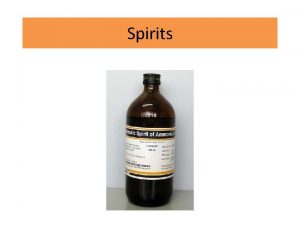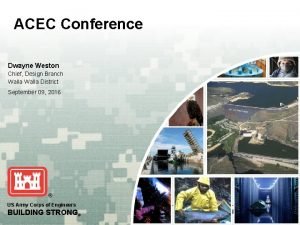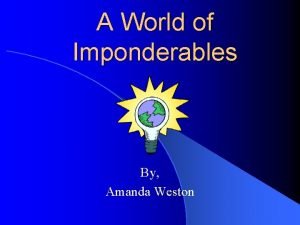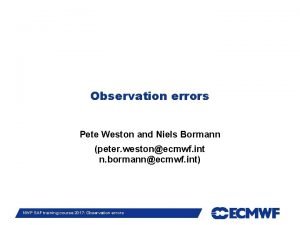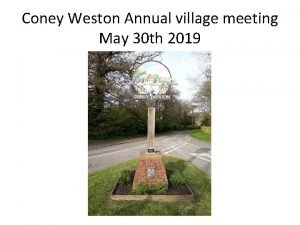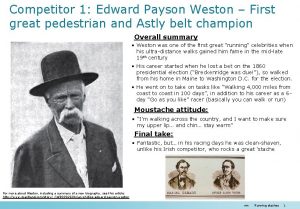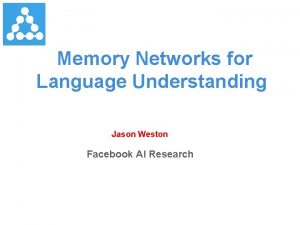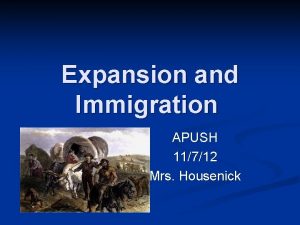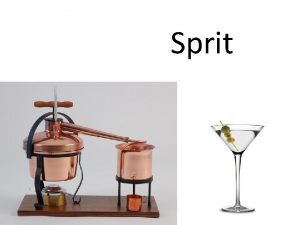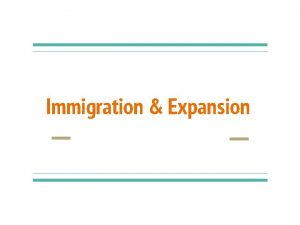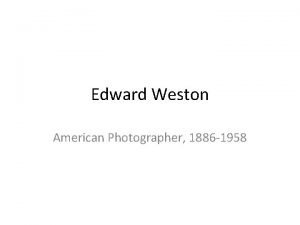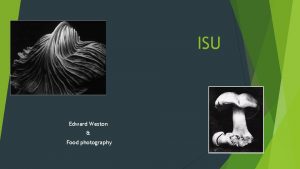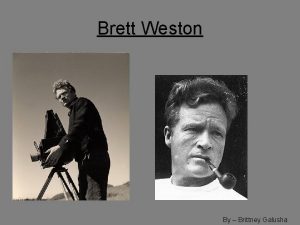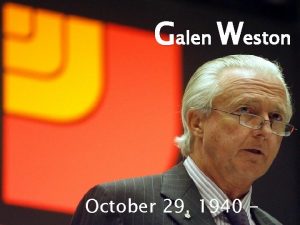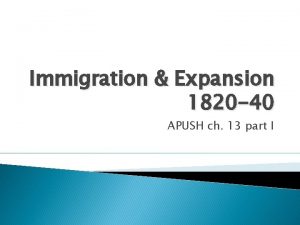Expansion and Immigration APUSH 11206 Ms Weston Sprit













- Slides: 13

Expansion and Immigration APUSH 11/2/06 Ms. Weston

Sprit of expansionism Both in terms of geography and new technology n Movement West, but also invention of new technology, manufacturing potential, transportation. n During Jacksonian Era, rise of national market economy. n

The Westward Movement n n n West exemplified America Population young, always on move West “Demographic center” of population consistently moving West Pioneer life difficult—lack of food, clothing shelter; disease, depression and death common Tough and crude frontier life Spirit of individualism

Effects on the Land Pioneers exhausted land n Found ways to tame the land (i. e. Kentucky Bluegrass) n Annihilation of beaver and buffalo and sea otters n ECOLOGICAL IMPERIALISM: aggressive exploitation of West’s land natural resources n

Reverence and Respect for Land n n n Pride in distinctiveness of American landscape (especially with increasing nationalism) George Catlin—painter and advocate of a national policy to preserve nature Later inspired idea of national park system (Yellowstone in 1872)

Population Changes n n n Incredible population growth (still x 2 every 25 years) By 1860 now 33 states Growth of large cities— New York, New Orleans, Chicago

Problems of Urban Growth n n n Smelly slums Bad street lighting Lack of police Impure water Inadequate sewage system and garbage disposal

Immigration Relatively slow before 1840 n From 1840 -1850, 1. 5 million immigrants n Mostly Irish and German n Push Factors: Over-crowding in Europe, lack of economic opportunity n Pull Factors: America as the land of freedom and opportunity (“America letters”), faster transportation with steamships n

Irish Immigrants n n n Problems in Ireland: Oppressed by Britain, potato famine Irish population in US outnumbers population in Ireland Irish immigrants stayed in cities —esp. Boston and New York n Most in slums n Lots of anti-Irish sentiment (NINA signs) n Anti-Catholicism n Most difficult, low-paying jobs n Riots with African. Americans

“Success” for Irish immigrants n n Many able to buy land Many became involved in politics, especially in political machines (Ex. Tammany Hall) n n n Became bosses—meet Irish immigrants, give coal, food and shelter to them in exchange for votes. Became key to Democratic party Irish relatively easily assimilated into American society

The German “Forty-Eighters” n n n Most were farmers, suffered crop-failures in Germany, some came because of failed democratic revolutions Most who came had some money, able to move West and get land. German influence in American life: Conestoga Wagon, Kentucky rifle, Christmas tree, kindergarten Some anti-German attitudes—especially in regards to drinking More accepted because had money, and lived in own separate communities (ex. Amish)

Rise of Nativism n n n Response to “invasion” of immigrants in 1840 s and 1850 s Fear that immigrants would take over from “native” people Major fear of Catholic takeover Formed “Know-Nothing” Party in 1850 s—wanted restrictions on immigration, laws to deport immigrants Mass violence against immigrants— esp. Catholic churches (in Philadelphia, 13 killed, 50 wounded in many days of fighting)

Immigration and Industrialization Immigrants needed industrialization so they would have jobs when they came to the US n Industrialization needed immigrants as a labor supply for these new factories. n
